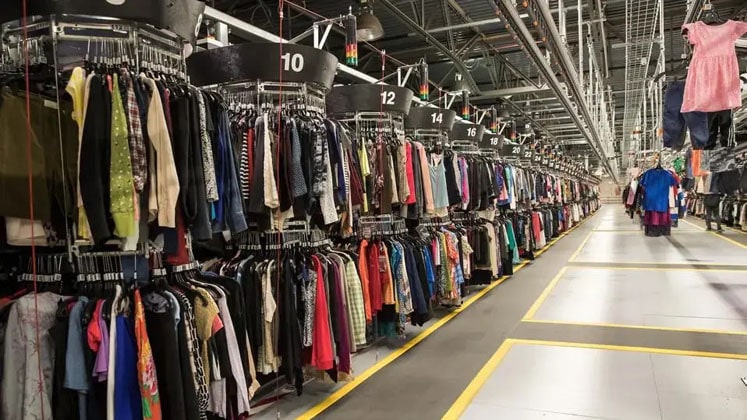FW
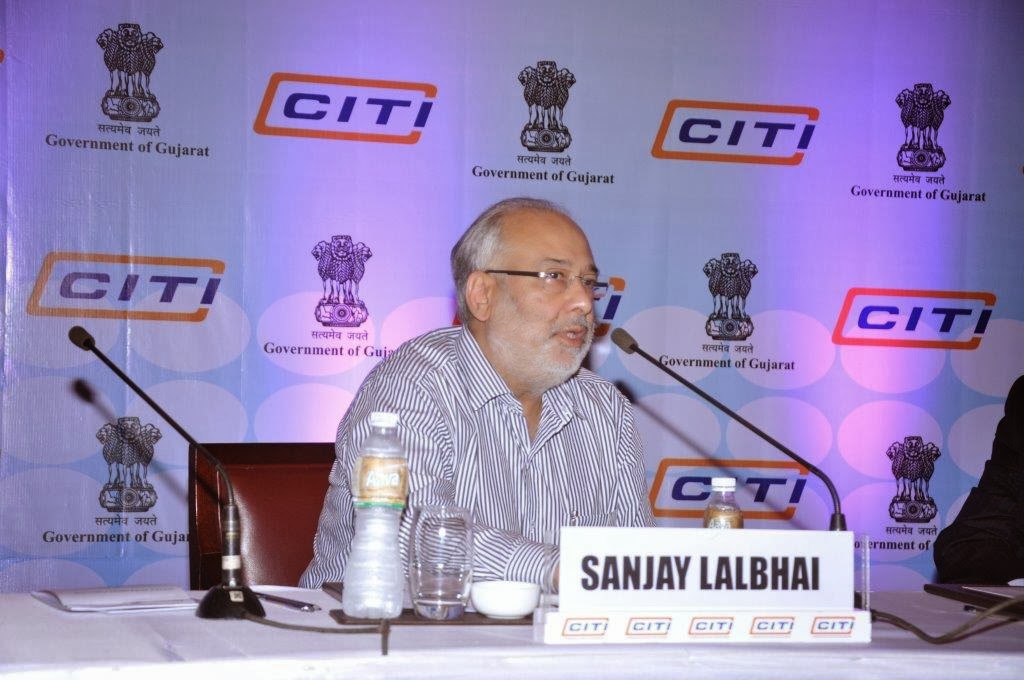 At a recent CITI conclave held in Ahmedabad, Gujarat, the doyen of the Indian textile industry, Sanjay Lalbhai, CMD of textile conglomerate Arvind spoke at length about India’s position in global textile market and how we can race ahead to achieve the ‘Brand India’ status. Speaking to Arvind Singhal, Chairman, Technopak Advisors, he answered several queries related to state of textile industry, Lalbhai said, “Indian textile companies need to go vertical and also set-up large scale apparel manufacturing plants, if India wants to increase its market share in the global textile trade.”
At a recent CITI conclave held in Ahmedabad, Gujarat, the doyen of the Indian textile industry, Sanjay Lalbhai, CMD of textile conglomerate Arvind spoke at length about India’s position in global textile market and how we can race ahead to achieve the ‘Brand India’ status. Speaking to Arvind Singhal, Chairman, Technopak Advisors, he answered several queries related to state of textile industry, Lalbhai said, “Indian textile companies need to go vertical and also set-up large scale apparel manufacturing plants, if India wants to increase its market share in the global textile trade.”
Need to gain competitiveness
Singhal pointed out that in the early ’90s, China’s and India’s textile industry were not 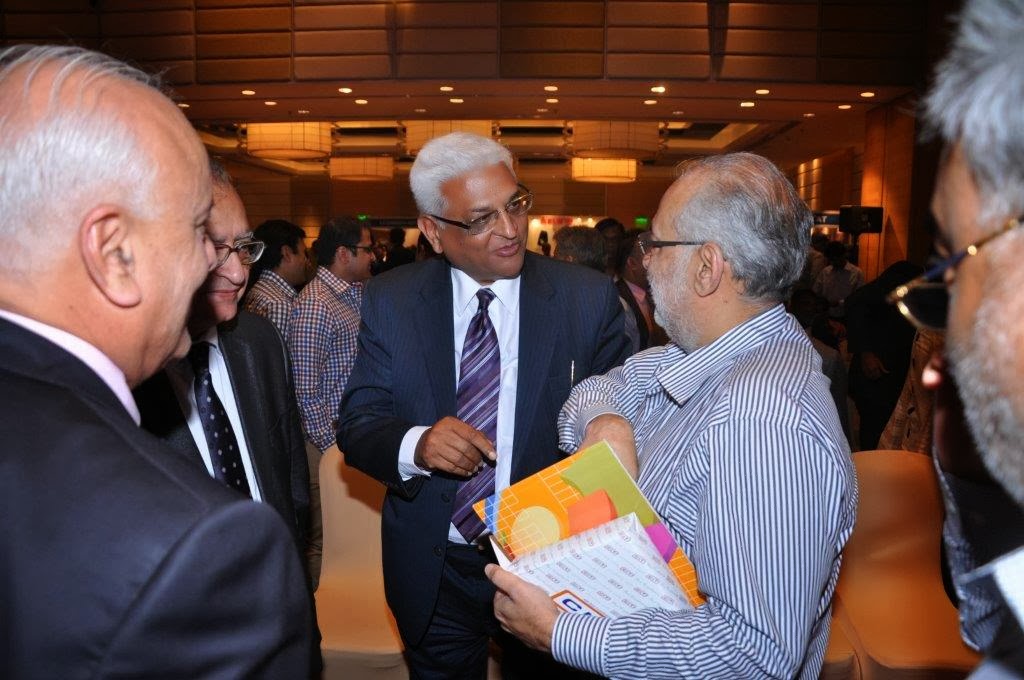 too far apart. However, today China’s industry is seven times that of India’s. Explaining the reason behind this Lalbhai said world trade in 2003 was $430 billion (over Rs 25,00,000 crores) by 2012 it was $750 billion dollars (over Rs 45,00,000 crores). It’s likely to be $1,150 billion (over Rs 69,00,000 crores) by 2020. In 2003, we were 3 per cent of world trade, by 2012 we were 4.5 per cent, while China was 17 per cent in 2003, now its 33 per cent. The reason behind this is that India has not been able to think ‘scale’. We have not gone for ‘verticalisation’.
too far apart. However, today China’s industry is seven times that of India’s. Explaining the reason behind this Lalbhai said world trade in 2003 was $430 billion (over Rs 25,00,000 crores) by 2012 it was $750 billion dollars (over Rs 45,00,000 crores). It’s likely to be $1,150 billion (over Rs 69,00,000 crores) by 2020. In 2003, we were 3 per cent of world trade, by 2012 we were 4.5 per cent, while China was 17 per cent in 2003, now its 33 per cent. The reason behind this is that India has not been able to think ‘scale’. We have not gone for ‘verticalisation’.
He stressed on the need to grab business away from China, especially when China has become more expensive than India. “We still depend on Bangladesh, Cambodia, Vietnam, Sri Lanka to convert our fabrics into garments. Major buyers in the US and Europe want to shift business from China to India but they don’t know where the conversion to the final garment will happen. Bangladesh is facing compliance issues. So things are uncertain there. India should take up garmenting seriously and build scale,” he asserts.
He also emphasized that we have to take advantage of the domestic market and create scale. “It’s necessary to have scale in value based products. We require a more competitive framework in raw materials. There are companies in raw materials where scale is not an issue. Even with cellulosic fibers there are huge opportunities in women’s wear. We can bring joint ventures into the country,” he explains.
Finding of textile sector’s strengths
Despite Indian textiles industry being the largest employer, contributing to the GDP, it has not been able to create good value to its investors. “It is the joint effort of players put together that textile should give value to its investors. People who are investing in our companies want good returns. These are the challenges and the problems which the textile industry has faced and I would say all of us have faced,” he opines.
Elaborating on creating an “asset light” model, he said, “There are so many entrepreneurs in India today who are willing to invest in a spinning capacity, so many investors are ready to invest in our weaving capacity. What we have started doing is, when an entrepreneur approaches us with investment proposal, we say, we assure you 18 per cent return on your investment. Now where would you get 18 per cent return, it is not that simple.
However, luckily, he says, we are the most supported industry in the country. “We have got good support from the government. We should always invest in value added areas like processing, distributions; invest in creating a capability of products and design innovations, becoming more customers centric. We should look at the development of clusters like Tirupur, Surat or Bhiwandi in the textile industry. We should look at creating an asset light model, so that I can go back to my investor and say now rate my textiles at par with brand & retail. We should rethink and if the Top 20 companies do not rethink this the industry will not get re-rated. It is a joint responsibility,” he avers.
Lalbhai said that there are companies in China which are trading at big PE. There are hardly any companies which are trading big on PE. It is not that these companies in China are very different and the idea cannot be replicated here. Possibilities are everywhere, brand India will only emerge if we become customer centric. He rued that our mentality is more towards creating assets, which is the easiest thing to do. We always look to invest in modern machinery, get subsidy from the government, run it as easily as possible.
He stressed on the need to bring in professionalism into the business. “You have to create value and bring in the best minds. You have to create a younger organisation. You can’t create scale without empowering. This is what has to be done for creating value additions in textiles,” he summed up.
Not satisfied with its trade in cotton and textiles with Vietnam, India is now looking at pushing up business. The market share of Indian cotton fiber in Vietnam was 16.5 per cent last year, far below the average level in other markets. Cotton fabric has a 0.58 per cent market share in Vietnam – much lower than the average world level of 26 per cent. As a result, a 20-member business delegation operating in fabric, cotton fiber, denim and jeans cotton from India is visiting Vietnam to seek cooperation opportunities in that country.
In 2013, Vietnam exported garments and fibers worth over $77 million to India, a year-on-year increase of 38 per cent. It imported $419 million worth of garment materials from the South Asian country, up 46 per cent. India feels it can supply Vietnam quality yarns and fabrics at the right price since India has emerged as the world's most competitive manufacturer of these products. Indian textiles are seen as a good partner for Vietnamese textiles to reduce cost of production.
Despite inflation, rising labor costs and a limited value chain for textiles, Vietnam is still one of the fastest growing textile and apparel producers. By 2025, the Vietnam textile and garment industry is expected to produce $35 billion worth of apparel exports, double the current production.
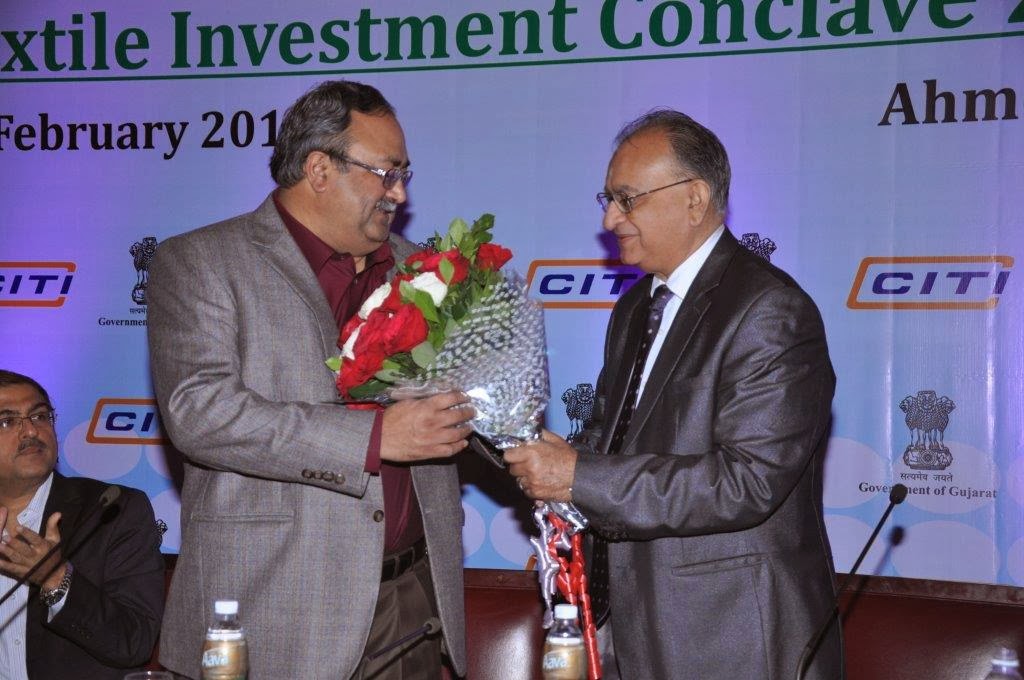 CITI orgainsed a 'Textile Investment Conclave' at Hotel Courtyard by Marriott at Ahmedabad, Gujarat on February 11, 2014. Experts deliberated on the textile industry in India and endorsed Gujarat as one of the most investment friendly destinations in the country. Gujarat was the partner state at the conclave. The one day event was inaugurated by Gujarat’s minister of state for industry Saurabh Patel.
CITI orgainsed a 'Textile Investment Conclave' at Hotel Courtyard by Marriott at Ahmedabad, Gujarat on February 11, 2014. Experts deliberated on the textile industry in India and endorsed Gujarat as one of the most investment friendly destinations in the country. Gujarat was the partner state at the conclave. The one day event was inaugurated by Gujarat’s minister of state for industry Saurabh Patel.
In his inaugural address, Patel said, “In Gujarat we believe in inclusive growth. The last 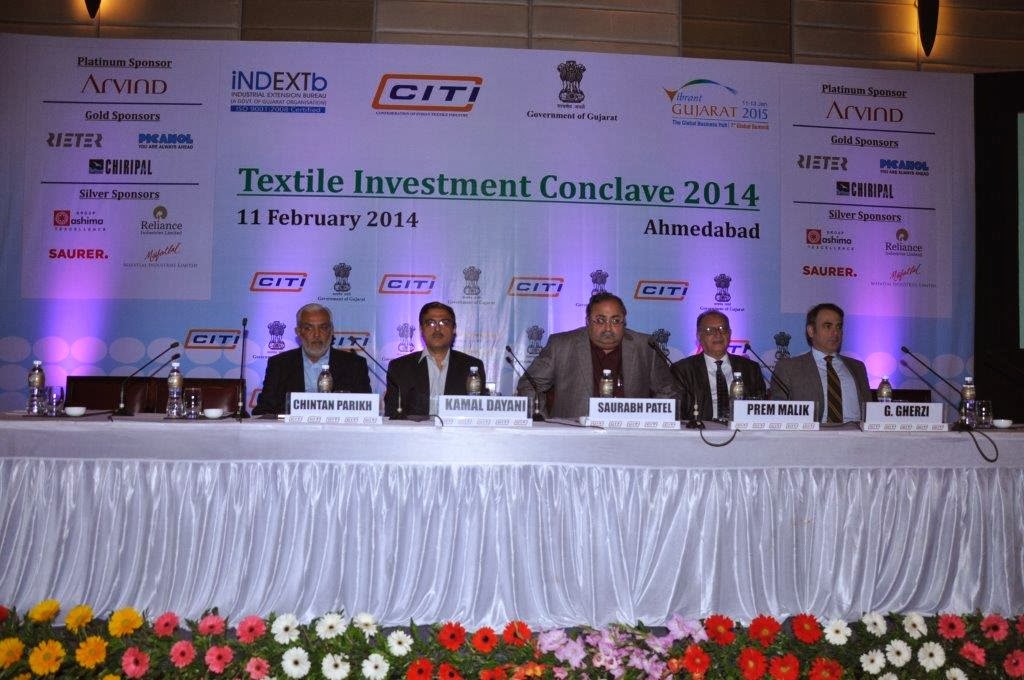
decade has been good for us, especially where the manufacturing sector is concerned. Today, we are practically number one in the country. Out of the total GDP, 27 per cent is the share of the manufacturing sector and 25 per cent of exports are produced in Gujarat. We decided to increase our GDP share and focus on certain areas. Textiles is one of them. We came out with an aggressive textile policy. In five to seven years, Gujarat will be one of the biggest textile hubs in the country.”
Welcoming the delegates, Prem Malik, Chairman, CITI said that historically the textile and clothing industry has been one of the pivotal manufacturing segments of Gujarat. Both Gujarat and Mumbai were called the Manchester of India and there are 60 mills in Ahmedabad alone. “Even after extensive industrialization, textile and raw materials continued to be one of the largest and highly successful contributors to the economy of the state. Gujarat is the largest cotton producing state. It has a one-third share of the total crop production in the country. It is the largest manufacturer of manmade fiber and filament. Among the value added products Gujarat has a phenomenal position, be it cotton fabrics, denims, manmade fibers, garments, technical textiles, made-ups,” he said emphasizing the state’s strong position as an investment destination.
Gujarat in focus
Elaborating on sharpening the strength, Malik further said, “The fact remains that Gujarat needs a higher textile production for using its raw material strength in full. Gujarat cotton has been leading the textile industry all over the country and even other textile producing countries. Transportation costs need to be reduced.”
Gujarat’s textile policy, encourages industrialists to look seriously for fresh investment opportunities in the state. “The textile policy has created a multiplier effect on the textile economy of India. Several other states have come forward with their own textile policies with incentives and other options. But Gujarat has the first mover advantage and the most attractive package for the textile industry,” he added.
Reiterating a similar point, in his keynote address, Kamal Dayani, Industries Commissioner of Gujarat, said, “Gujarat is the largest cotton producer in the country. But we export a lot of cotton because we don’t have the capacity to absorb it. Why can’t we have value addition in cotton like yarn or fabric and export garment than raw cotton? With this aim in mind the government of Gujarat came out with a textile policy one and a half years back. It covered the entire value chain right from farm to fabric. Lots of investment intentions have been expressed. About ten textile and spinning parks have been approved in principle. Maybe in a year and a half we should see these investments taking off.”
He said the textile policy also encourages processing, garmenting, ginning. “We encourage investors to go through this policy in detail and make wise commercial investments. I hope Gujarat turns to be a major destination for investments in the textile sector. Technical textiles have huge applications. Infrastructure also uses technical textiles abroad though in India this hasn’t happened. Keeping this in mind we have a technical textile chapter in our policy. We want units located in Gujarat to capture at least 50 percent of the market for technical textiles.
The government of Gujarat has approved two centers of excellence. One is exclusively for technical textiles and that’s located in Surat. One is on composites. We expect the new textile policy to bring in Rs 30,000 crores of investment in the next four years to Gujarat,” he added.
Malik pointed out that this is the time to sharpen competitive edge in textile production through domestic and international investments and to optimize the trade benefits in global textile and clothing markets. “The total production of textiles in India is $100 billion. This year exports will cross $40 billion from 34 billion last year. We have abundant raw materials, a large work force, a long textile tradition and entrepreneurship. India has tremendous potential to achieve tremendous growth in production and export of textile products. We have a large youth population and growing disposable income. This section will demand lifestyle products. And the textile sector will be a major beneficiary,” he opined.
Lalbhai on Indian textiles and growth triggers
Sanjay Lalbhai, CMD of Arvind in his interaction with Arvind Singhal, Chairman, Technopak delved on the state of Indian textile industry as a whole. He emphasized on the need to go vertical and set-up large scale apparel manufacturing plants, if India wants to increase its share in the global market.
He said that world textile trade in 2003 was $430 billion (over Rs 25,00,000 crores) by 2012 it was $750 billion (over Rs 45,00,000 crores). It’s likely to be 1,150 billion dollars (over Rs 69,00,000 crores) by 2020. “In 2003 we were 3 per cent of the world trade, by 2012 we were four and a half per cent, and China was 17 per cent in 2003, now that’s 33 per cent. But we have not been able to think scale. We have not gone for verticalisation.”
He pointed out that India has not been able to get business away from China even though China has become more expensive than India. “We still depend on Bangladesh, Cambodia, Vietnam, Sri Lanka to convert our fabrics into garments. Major buyers in the US and Europe want to shift business from China to India but they don’t know where the conversion to the final garment will happen. Bangladesh is facing a compliance issue. So things are uncertain there. India should take up garmenting seriously and build scale,” he added.
Talking about emergence of brand India, he said, “Brand India will only emerge if we become customer centric. So if we want to boast and differentiate with the very value added products coming from Italy or any of the European destinations then we have to invest in product development and design.” He expressed his views on several issues like increasing domestic demand, strengths of Indian textile industry, building brand India, advent of IT and E-commerce and South Africa, as emerging destination among others.
Focus on building industry strengths
Interactive sessions on subjects like textile policy of Gujarat and its impact, global textile scenario and technical textiles were also held during the day. The first session discussed subjects like growth opportunity in cotton textiles in India and Gujarat, cotton and its complexities for the Indian industry, investment opportunities in VSF and comparative analysis of state level textile policies. Experts like V K Ladia, Chairman, Rajasthan Texchem, Rajesh R Mandawewala, Managing Director, Welspun India, Sanjay Jain, MD, TT, Ajay Sardana, Assistant VP, Global Customers & Market Intelligence, Birla Cellulose-Pulp & Fibre Business, Grasim, Vishal Chiripal, CEO, Chiripal Industries focused on the state’s business potential.
The second session for the day was about global textile scenario. Experts highlighted on subjects covering US textile industry, India-Korea partnership in textile industry, promising future of investments in weaving industry, business opportunities for textile machinery industry and textile industry in South Africa. among others. The third session on technical textiles saw experts like Pramod Khosla, Chairman, Indian Technical Textile Association, Anup Rakshit, Head – MTS and Product Development, Polyester Sector – PSF Business, Reliance Industries discussed scope of synthetics and technical textiles.
Première Vision is acquiring, the Cuir à Paris show from its current owners SIC, which is a division of the professional organisation of the French leather industry. The acquisition is happening through Première Vision’s subsidiary Modamont
Première Vision is a worldwide leader in fashion industry trade shows.
The operation will be effective as of March 2014 and will allow Première Vision to organize the Cuir à Paris show from the September 16 to 18, 2014, edition. Cuir à Paris is a 15-year-old show specializing in leather and fur for international fashion and design industry professionals.
This acquisition allows Première Vision to integrate itself with the leather and fur sector. This is a market that has proved particularly vigorous in recent years in terms of high-end and luxury brands in the apparel, leather goods and footwear sectors. For its part, Cuir à Paris will benefit from the expertise of the Première Vision company, which will pursue and strengthen its previous development policy to energise and promote the show, including possibly bringing this industry sector to certain of its international events.
Première Vision has been organising shows and events for professionals in the international fashion and textile industry for 40 years. The shows offer visitors creative services and unique fashion information.
www.premierevision.com/en
US retail apparel prices are expected to show little change in the coming months, despite an anticipated 10 to 15 per cent drop in the price of cotton by the end of the year. Fiber prices are expected to decline because of an anticipated cutback in US exports to China and because US farmers will be planting more cotton this spring.
But the cotton price decline is not likely to result in an equivalent drop in the price of apparel because other factors, from design to transportation, contribute to the price of the finished product. Fiber prices are just a fraction of apparel prices. The US has yet to see any decline in apparel prices even though both fiber and import prices are lower. So apparel prices will not be significantly affected by the behavior of fiber prices.
For the US China's management of its giant cotton stocks will be the major determinant of cotton prices for the year. China has planned to end its accumulation of cotton stocks and is expected to cut its cotton imports to 6.4 million bales this year down sharply from 11 million bales in 2013.
Cornell will require its apparel licensees who have garments manufactured in factories in Bangladesh to sign and abide by the ‘Accord on Fire and Building Safety’ in Bangladesh. The accord is a legally binding, five-year agreement between apparel manufacturers and global and Bangladeshi trade unions. It was created in the wake of the disasters that struck factory units in Bangladesh including fires and building collapses last year.
Cornell is taking this step to ensure that workers who make Cornell logo apparel do not have to work in buildings that are structurally unsound or lack proper fire safety measures. The accord calls for independent inspections by trained fire- and building-safety inspectors at factories used by members of the accord. When problems are found in a factory, the companies using the factory will share the costs of retrofitting the structure. To date, more than 130 companies have signed the accord. Collectively, they do business with more than 1,600 Bangladeshi factories employing more than 2 million workers.
Cornell University is based in the United States. Cornell is the sixth university in the US to add the accord to their licensing requirements. Five of the 18 Cornell licensees who have disclosed sourcing goods from Bangladesh have already become signatories to the accord. They include Adidas and Fruit of the Loom.
China’s apparel exports have got off to a strong start this year. The figures show a surge of 13.4 per cent year-on-year in January. Both apparel shipments and textile exports from China have jumped compared to a year earlier. Exports of textile products and apparel reached $283 billion in 2013, up 11.4 per cent from 2012, compared to only a 2.8 per cent growth year-on-year in 2012.
Chinese textile and clothing industry exports are expected to grow by at least by 8 per cent year-on-year in 2014 thanks to the a recovery of US and European Union markets. With textile exports remaining high in January, and finished product inventory less than expected, the price of textile products was raised slightly during the month. High domestic cotton prices have also been inflating costs for Chinese textile and clothing producers.
The government began selling off some of its national cotton reserves in November. There are plans to replace the national cotton reserve program with a system of subsidies, which would help narrow the difference between Chinese cotton prices and the cotton price on the global market - largely lowering the cost for Chinese manufacturers.
Imperial will implement Lectra Fashion to reinforce its position in the fast fashion market and support its worldwide business growth. Imperial is a fast fashion brand from Italy. First specialized in menswear and women’s wear, the ready-to-wear brand has expanded its activities to include retail in 2012. The company delivers six million pieces per year. With the company growing at a very fast pace, it needed to master end-to-end development process. The challenge was to cope with increasing activities, while continuing to deliver up-to-date quality collections on time. It decided to integrate Lectra Fashion PLM to speed development while better connecting teams involved in the collection process, from design to final product. Lectra Fashion is expected to ease day-to-day work and streamline the development process. The partners have shared a relationship for the last 18 years.
Imperial’s plan is to go one step further and share pre-production and production data by opening its Lectra Fashion PLM to material or service suppliers via a web platform. Lectra is the world leader in integrated technology solutions dedicated to industries using soft materials—fabrics, leather, technical textiles and composite materials.
www.imperialfashion.com/en.html
www.lectra.com/
The 16th edition of Texworld USA showcased 268 exhibitors from 18 countries an 11 per cent increase over January 2013. The winter edition featured four international pavilions including Turkey, Taiwan, Egypt and Pakistan covering 12 product categories to offer buyers an extensive array of fabrics, textile accessories and sourcing options. Visitors came from 43 countries including, United States, Canada, Mexico and India.
“Leading fashion buyers from Macy’s, Ralph Lauren Denim & Supply and Armani Exchange, to name a few, attended the sixteenth edition of Texworld USA despite the snowy weather conditions, proving that Texworld USA remains the premier apparel fabric sourcing destination in North America,” remarked Kristy Meade, Group Show Director, Messe Frankfurt in a company statement.
In collaboration with CCPIT-TEX, the fifth edition of the International Apparel Sourcing Show was once again co-located with Texworld USA and featured 63 exhibitors from seven countries. Returning exhibitors from China, Bangladesh, Egypt and India completed the overall supply chain by offering contract manufacturing, original design manufacturing and private label development.
Texworld Paris Art Directors, Louis Gerin and Gregory Lamaud created a thought provoking, interesting and relevant Trend Forum highlighting the spring/summer 2015 trends and colour direction. The forum featured a collection of fabric swatches provided by exhibitors that could be sourced at the show. Texworld USA’s show partner, Lenzing Innovation, delivered 12 complimentary seminars to 570 attendees over the three day show period. A few of the popular topics included: Navigating Texworld USA, Global Sourcing, Stylesight’s Trend Presentation and Denim Innovation.
www.texworldusa.com
In a global deal, the historic textile mill in Huddersfield, Taylor & Lodge has inked a joint venture partnership with China’s textile giant Shandong Ruyi Technology Group. Owners Bulmer & Lumb Group has agreed to the deal for its Taylor & Lodge manufacturing unit at Albert Street.
As per Bahman Mostaghimi, Managing Director of Shandong Ruyi UK the joint venture will bring world-class textile technology, marketing and financial power of Shandong Ruyi together with the manufacturing and design skills of Taylor & Lodge. Shandong Ruyi will help Taylor & Lodge to improve international markets through upgrading its equipment and expanding its marketing.
Mostaghimi says China is known for its cheap products. From the start, they wanted to be one Chinese company where the customer is happy about the quality and service, but complains about the price.
Post the JV, a new company has been formed under the name of Taylor & Lodge (Huddersfield), which will be 80 per cent owned by Shandong Ruyi and 20 per cent by Bulmer & Lumb Group. Taylor & Lodge employs 65 people at its Rashcliffe Mills site. While, Shandong Ruyi supplies high-end suits to its customers including Marks & Spencer and John Lewis and indirectly to other retailers such as Moss Bros, Taylor and Lodge has built its reputation as a manufacturer of the finest, luxury British worsted cloths. In 1966, it was the first textile company in the world to get the Queen’s Award.










